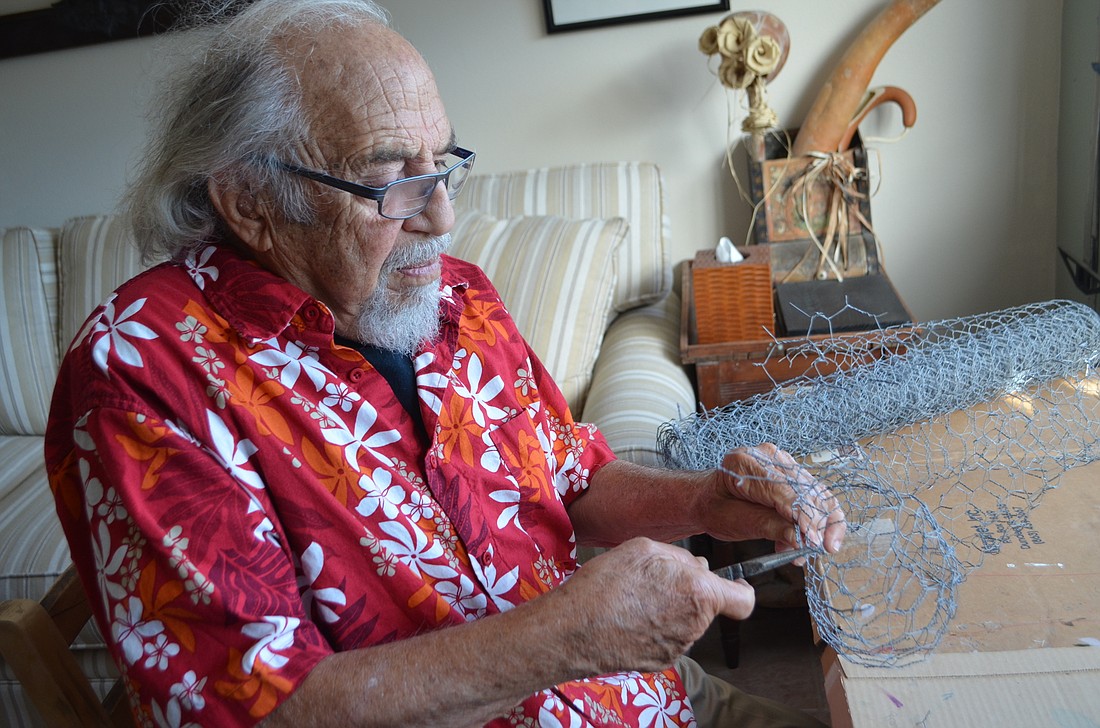- March 16, 2025
-
-
Loading

Marvin Levitt holds his wire cutters with just enough force to twist the chicken wire into the right position.
His wrinkled hands move swiftly and gently, like this is what they were made to do.
The wire is strong and steady enough to resemble a pair of legs. Levitt soaks a ripped piece of a brown paper bag in water, then weaves it around the wire in what he calls a butterfly pattern.
And although he’s unsure of what it will be exactly, it’s destined to be his latest masterpiece.
Levitt spends time in his home studio each day working on papier-mâché sculptures. He repeats the process of soaking brown bags or magazine pages and weaving them in and out of the wire until he has about five layers. The top coat is either a magazine page or a layer of acrylic paint.
“I have to get my hands dirty every day, otherwise my DNA has a problem,” Levitt said. “I feel that I’ve lost something. Something’s wrong with my day because my fingers didn’t get dirty and they have to be used.”
Levitt had a nearly 70-year career as an art teacher at Philadelphia’s Temple University, Bucks County public schools and the Long Beach Island Foundation of the Arts & Sciences in New Jersey. Now, at 91, he continues his love for art through sculpting.
Levitt said that at this point in his life, he does things that make him feel good. He spends his summers on Long Beach Island in New Jersey, and the art he creates there is on display at m.t. burton Gallery in Surf City, N.J. The art he creates at his winter residence on Longboat Key stays there.
Over the years, Levitt has collected candy wrappers, stamps and postcards to use for his papier-mâché work. His partner, Sue Gordon, is used to holding onto old wrapping paper.
“They’re interesting. They have texture and color and variations. Some have gold, some have silver, and so when she says, ‘Can I throw it away?’ I say, ‘No, I think we have to use it,’” Levitt said.
It takes him about two or three weeks to finish one papier-mâché sculpture, but when one is completed, it’s placed among the other items Levitt has made in his home.
He calls his house a small museum. His paintings adorn the light blue walls of the living room, and his sculptures rest on tables and counters around his home.
“But it’s amazing to see the finished products because it’s a lot of work,” Gordon said. “It looks like nothing, and all of a sudden it’s a person.”
Levitt calls himself an innovator. He can’t recall exactly how he got into art, though he remembers being able to draw what he saw and taking lessons in elementary school.
Levitt got in trouble for doodling in class while his history teacher was talking about George Washington crossing the Delaware River. It wasn’t until Levitt’s mother was called to the school that the teacher actually looked at Levitt’s drawing. On his piece of paper was an illustration of Washington making the famous crossing.
Levitt’s paintings are drawn from his life. The beach is a popular subject for his paintings. But he also draws on his past. Levitt grew up in the 1930s and ’40s, the Depression years. He uses symbols from those years as inspiration — old trucks, broken down houses and debris.
Today, he enjoys going to museums and seeing what other artists have done.
“I don’t copy artists or anything like that,” he said. “But for some reason it’s like plugging in and getting vibes and seeing what people did in the past.”